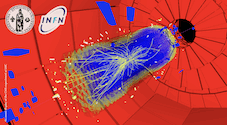Speaker
Mr
Andreas Ritter
(Max-Planck-Institute for Physics - Semiconductor laboratory)
Description
For the upgrade of the Belle II detector DEPFET (Depleted p-channel field effect transistor) pixels are foreseen for the two innermost layers of the vertex detector. As a MOS device, the DEPFET is susceptible to ionizing radiation, which will be created near the interaction point.
One effect of ionizing radiation is the build-up of positive charge in the oxide insulation layer near the silicon interface. This positive charge leads to a change in the threshold voltage of the transistors. The readout of the individual ladders of the pixel detector is organized in a rolling shutter mode, switching one row on at a time. As the switching chips provide only one voltage, careful adaption to this shift is necessary.
To increase the radiation hardness of the detector, thinner oxides in addition with various layers of nitride are under investigation. Therefore special test structures (FETs) have been developed and irradiated with a 60keV x-ray tube. These structures correspond to several critical regions of the DEPFET, like the gate or the clear-gate. Change in the transistor parameters, like threshold voltage or subthreshold swing have been measured and will be presented.
Author
Mr
Andreas Ritter
(Max-Planck-Institute for Physics - Semiconductor laboratory)
Co-authors
Andreas Wassatsch
(Max-Planck-Institute for Physics - Semiconductor laboratory)
Andricek Ladislav
(Max-Planck-Institute for Physics - Semiconductor laboratory)
Christian Koffmane
(Max-Planck-Institute for Physics - Semiconductor laboratory)
Hans-Günther Moser
(Max-Planck-Institute for Physics - Semiconductor laboratory)
Jelena Ninkovic
(Max-Planck-Institute for Physics - Semiconductor laboratory)
Rainer Richter
(Max-Planck-Institute for Physics - Semiconductor laboratory)

